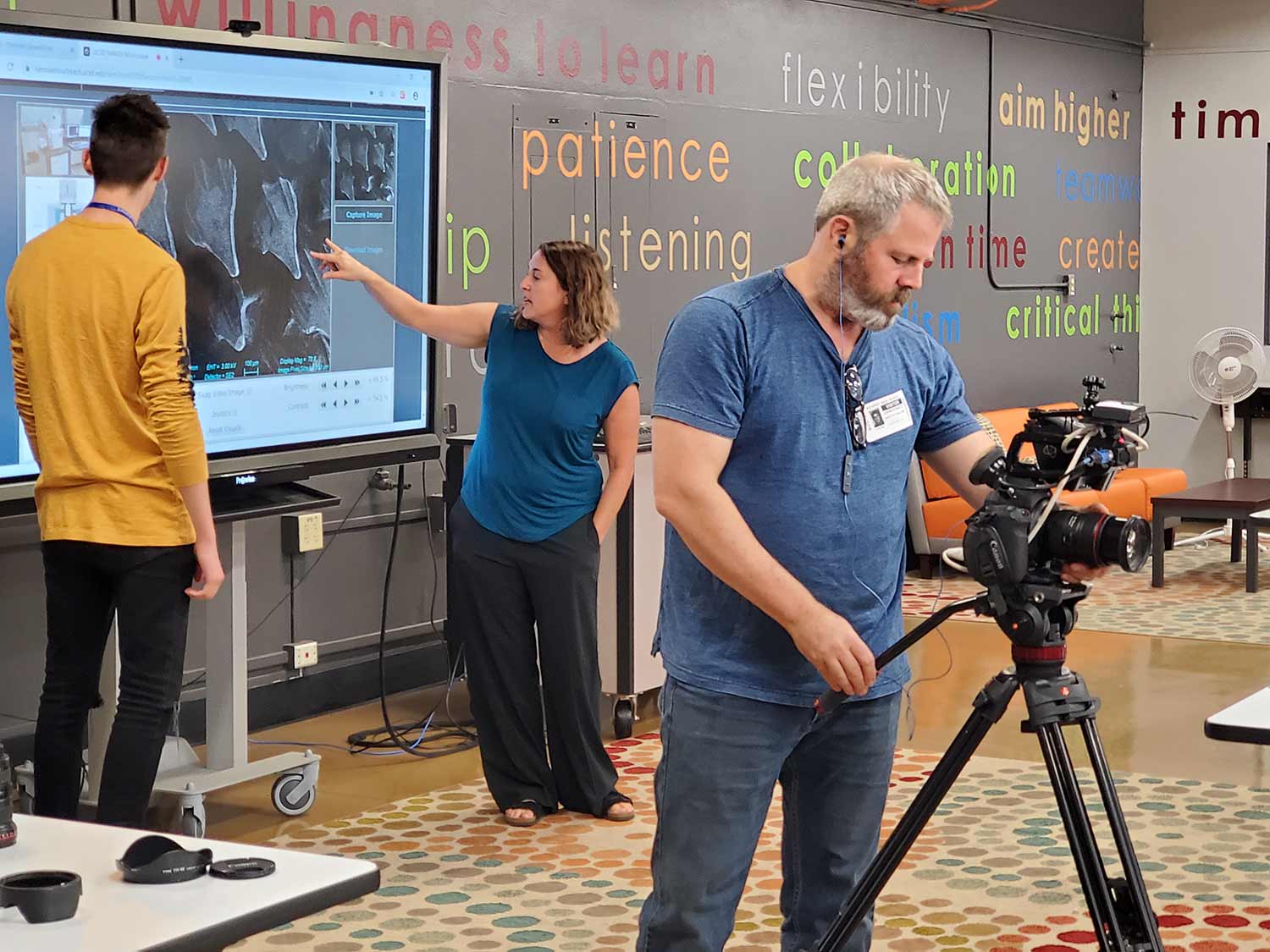
By:
- Xochitl Rojas-Rocha
Published Date
By:
- Xochitl Rojas-Rocha
Share This:

Teacher Lesli Horowitz and a student study a magnified image of shark scales during an outreach session. A CBS videographer films the class's reaction. Photo by Xochitl Rojas-Rocha/UC San Diego
Living Life on the Nanoscale
Outreach efforts by Qualcomm Institute researchers and students bring wonders of nanotechnology to California high school students
Under the invisible beam of the scanning electron microscope, the bottom of a gecko’s foot resolved into a field of tiny hairs. As both sample and microscope sat miles away in the Nano3 laboratory of UC San Diego’s Qualcomm Institute, a high school biology class at the Kearny School of College Connections used a touch screen to zoom in and out and examine the sample in detail. With 60,000 times the magnification and more than 500 times the resolution of the average classroom microscope, the high-powered machine offered students a rare chance to see the world as scientists.
“It’s like [the students] had unique access to a tiny, secret world that most people don’t get to see,” said class teacher Lesli Horowitz. “That was truly novel for them and I believe it made them feel special.”
Over the course of approximately half an hour, Horowitz’s students took turns using a touch screen to remotely control the “zoom” and “focus” functions of the scanning electron microscope, or SEM. With the guidance of undergraduate researchers at the Qualcomm Institute working the SEM on the other side, the students pored over the serrated edges of a shark’s scale, a spiked grain of sunflower pollen, and a strand of human hair.
The event is featured in a new Innovate8 segment from CBS8.
A Place for Nanotechnology at Every School
Outreach sessions like these are a building block in a larger effort led by the San Diego Nanotechnology Infrastructure (SDNI) at the Qualcomm Institute, UC San Diego. One of 16 such sites nation-wide, SDNI offers government, industry and academic laboratories access to nanotechnology facilities where visitors can create microscopic devices for use in medicine, science and engineering. Devices only nanometers (billionths of a meter) wide are being used to do delicate work, such as delivering medicine directly to cancer cells.
Despite nanotechnology’s promising future, most California schools lack a science curriculum that engages students with life and technology on the nanoscale. Opportunities like that of Horowitz’s class, in which young students can study the arrow-like shape of a shark’s scale, and understand how its form reduces drag and propels the animal through the water, are relatively rare.
“We need to make conscious efforts to close this gap in STEM education or the gap can be widened over time. SDNI is committed to this effort and we have both the means and the opportunities to do an effective job. The unique set of tools for nanotechnologies can reveal nature’s incredible beauty and unlock the imaginations of the students, which motivates them to pursue a STEM career,” said SDNI Director Yu-Hwa Lo.
Now, SDNI is using resources developed at its main facility, Nano3, to expand outreach to high schools and community colleges, and inspire curiosity about nanotechnology in a new generation. Since January 2019, SDNI’s Director of Education Programs and Outreach, Yves Theriault, has reached out to teachers, school districts, and the San Diego County Office of Education to bring the wonders of nanotechnology to more than 2,000 students across the county. SDNI’s ultimate goal is to establish a rigorous nanotechnology curriculum at educational institutions statewide by 2025, and provide an education in nanotechnology to all students, especially those from underrepresented groups.
Raising a New Wave of Researchers
The Qualcomm Institute’s Nano3 lab takes an active role in training new researchers. The lab—named “Nano3” for its strengths in nanoscience, nanoengineering and nanomedicine—continually engages undergraduate students in ongoing research projects. Three undergraduates, in particular, have helped SDNI schedule and lead outreach sessions with their younger counterparts. Theriault says that the experience has been important for developing their sense of responsibility and strengthening their communication and teaching skills.
“As someone who has worked with students of all ages for over 15 years, bringing the gift of discovery and knowledge along with the empowerment of understanding of the world, science, technology, the planet, and life to someone provides a wonderful sense of giving, sharing, and empowering. It makes you feel like you are positively impacting humanity,” said Theriault.
Over the coming months, SDNI plans to continue leading SEM outreach with classes across California. Teachers interested in bringing the wonders of nanotechnology to their own classrooms can visit SDNI’s educational website to learn more, or request an outreach session through an online form.
For more on the Qualcomm Institute, home to innovative research on issues in society, technology, the environment, health and the arts, visit qi.ucsd.edu. The institute supports cutting-edge research that furthers advancements in STEM literacy, disaster response, cultural heritage preservation and more.
Share This:
You May Also Like
Stay in the Know
Keep up with all the latest from UC San Diego. Subscribe to the newsletter today.


